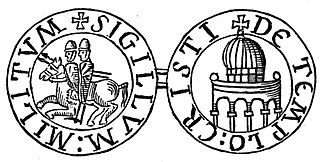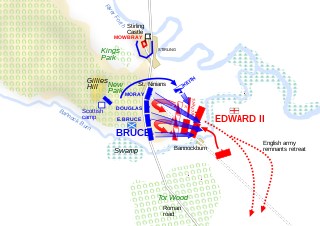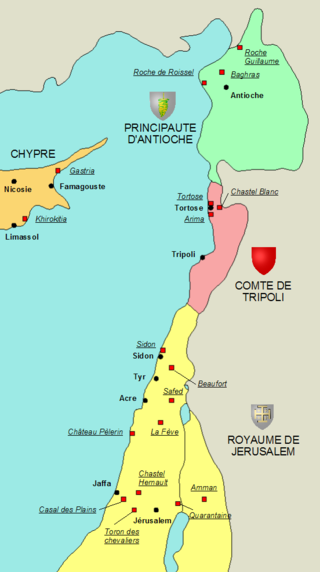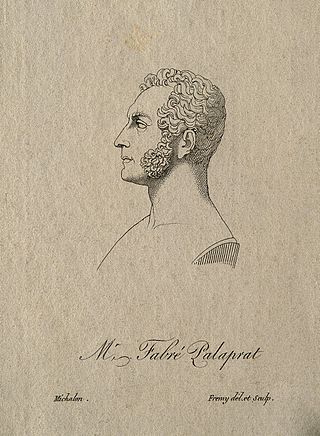
The Poor Fellow-Soldiers of Christ and of the Temple of Solomon, mainly known as the Knights Templar, was a military order of the Catholic faith, and one of the wealthiest and most popular military orders in Western Christianity. They were founded c. 1119, headquartered on the Temple Mount in Jerusalem, and existed for nearly two centuries during the Middle Ages. After their dissolution in 1312, several secret societies formed which eventually evolved into organizations such as the Freemasons and the Reconstituted Order of Christ

1314 (MCCCXIV) was a common year starting on Tuesday of the Julian calendar, the 1314th year of the Common Era (CE) and Anno Domini (AD) designations, the 314th year of the 2nd millennium, the 14th year of the 14th century, and the 5th year of the 1310s decade. As of the start of 1314, the Gregorian calendar was 8 days ahead of the Julian calendar, which was the dominant calendar of the time.

Jacques de Molay, also spelled "Molai", was the 23rd and last grand master of the Knights Templar, leading the order sometime before 20 April 1292 until it was dissolved by order of Pope Clement V in 1312. Though little is known of his actual life and deeds except for his last years as Grand Master, he is one of the best known Templars.

Geoffroi de Charney, also known as Guy d'Auvergne, was preceptor of Normandy for the Knights Templar. In 1307 de Charny was arrested, along with the entire Order of Knights Templar in France, and in 1314 was burned at the stake.
Mulay, Mûlay, Bulay was a general under the Mongol Ilkhanate ruler Ghazan at the end of the 13th century. Mulay was part of the 1299–1300 Mongol offensive in Syria and Palestine, and remained with a small force to occupy the land after the departure of Ghazan. He also participated in the last Mongol offensive in the Levant in 1303. His name has caused confusion for some historians, because of its similarity with that of the contemporary Grand Master of the Knights Templar, Jacques de Molay.

The Square du Temple is a garden in Paris, France in the 3rd arrondissement, established in 1857. It is one of 24 city squares planned and created by Georges-Eugène Haussmann and Jean-Charles Adolphe Alphand. The Square occupies the site of a medieval fortress in Paris, built by the Knights Templar. Parts of the fortress were later used as a prison during the French Revolution, and then demolished by the mid-19th century.

The Chinon Parchment is a historical document discovered in September 2001 by Barbara Frale, an Italian paleographer at the Vatican Apostolic Archive. On the basis of this document she has claimed that, in 1308, Pope Clement V absolved the last Grand Master, Jacques de Molay, and the rest of the leadership of the Knights Templar from charges brought against them by the Medieval Inquisition.
The Poor Fellow-Soldiers of Christ and the Temple of Jerusalem, or Templars, was a military order founded in c. 1120.

La Roche-Guillaume was a medieval fortress of the Knights Templar located near the Syrian Gates in what is now the Hatay Province of Turkey.

Otto de Grandson, sometimes numbered Otto I to distinguish him from later members of his family with the same name, was the most prominent of the Savoyard knights in the service of King Edward I of England, to whom he was the closest personal friend and many of whose interests he shared. His misrule of the Channel Islands, particularly after he left England following Edward's death, prompted greater care of the English kings when considering provision of future life estates.
Alain Demurger is a French historian, and a leading specialist of the history of the Knights Templar and the Crusades.
Laurent Dailliez was a French history doctor who graduated from Ecole pratique des hautes études. He was a researcher in medieval studies at the CNRS, a historian of the Crusades, and a specialist of the Knights Templar. Among other books, he wrote "Les Templiers". Dailliez was also the author of the article on the Templars in the leading French language encyclopedia, Encyclopedia Universalis.

Molay is a commune in the Haute-Saône department in the region of Bourgogne-Franche-Comté in eastern France.

Bernard-Raymond Fabré-Palaprat, was a priest and mystic who founded a neo-Templar order called l'Ordre du Temple in 1804 and the Johannite Church in 1812, and proclaimed himself Grand Master of the Templars and Sovereign Pontiff of the Primitive Catholic religion, opposing the Church of Saint Peter.
Hugues de Pairaud was one of the leaders of the Knights Templar. He and Geoffroi de Gonneville were sentenced to life imprisonment on March 18, 1314. They were spared the fate of Jacques de Molay and Geoffroi de Charney, who were both burned at the stake, because they accepted their sentence in silence.

In 1307, members of the Knights Templar in the Kingdom of France were suddenly charged with heresy and arrested after their leader, Master Jacques de Molay, had recently come to France for meetings with Pope Clement V. Many, including their leader, were burned at the stake while others were sentenced to perpetual imprisonment. The events in France led to a series of trials in other locations, not all of which had the same outcome.

The fall of Ruad in 1302 was one of the culminating events of the Crusades in the Eastern Mediterranean. In 1291, the Crusaders had lost their main power base at the coastal city of Acre, and the Muslim Mamluks had been systematically destroying the remaining Crusader ports and fortresses in the region, forcing the Crusaders to relocate the dwindling Kingdom of Jerusalem to the island of Cyprus. In 1299–1300, the Cypriots sought to retake the Syrian port city of Tortosa, by setting up a staging area on Ruad, two miles (3 km) off the coast of Tortosa. The plans were to coordinate an offensive between the forces of the Crusaders, and those of the Ilkhanate. However, though the Crusaders successfully established a bridgehead on the island, the Mongols did not arrive, and the Crusaders were forced to withdraw the bulk of their forces to Cyprus. The Knights Templar set up a permanent garrison on the island in 1300, but the Mamluks besieged and captured Ruad in 1302. With the loss of the island, the Crusaders lost their last foothold in the Holy Land and it marked the end of their presence in the Levant region.
Barbara Frale is an Italian paleographer at the Vatican Secret Archives. Frale has written books about the Templars and she has a special interest in the history of the Shroud of Turin. In September 2001, she found an authentic copy of the Chinon Parchment.

Requiem is a novel by Robyn Young set during the end of the ninth and final crusade. It was first published by E.P. Dutton in 2008.